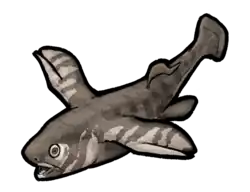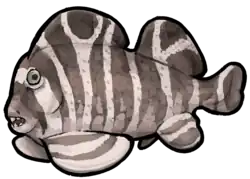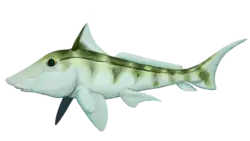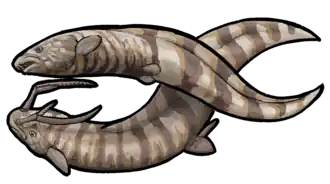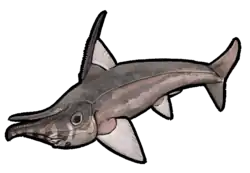Helicampodus
| Helicampodus Temporal range: Late Permian - Early Triassic,
| |
|---|---|
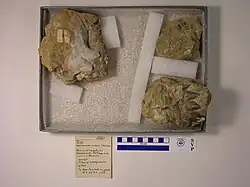
| |
| Holotype specimen of H. kokeni | |
| Scientific classification | |
| Kingdom: | Animalia |
| Phylum: | Chordata |
| Class: | Chondrichthyes |
| Order: | †Eugeneodontiformes |
| Family: | †Helicampodontidae |
| Genus: | † Branson, 1935 |
| Species | |
| |
Helicampodus is an extinct genus of shark-like eugeneodont fish that lived during the Late Permian to Early Triassic period. Fossils of Helicampodus have been found in Asia.[1] The largest teeth of Helicampodus kokeni are about 2.7 cm in length, which points to a maximum size of around 2 m based on its relatives.[2] It was earlier placed in the families Helicoprionidae and Edestidae,[3] but has more recently been placed in Helicampodontidae.[4]
References
- ^ "†Helicampodus Branson 1935 (chimaera)". Fossilworks.org. Retrieved 25 August 2023.
- ^ Itano, Wayne. "Helicampodus kokeni". researchgate.net. Retrieved 25 August 2023.
- ^ "Helicampodus ✝". mindat.org. Retrieved 25 August 2023.
- ^ Lebedev, O. A.; Itano, W. M.; Johanson, Z.; Alekseev, A. S.; Smith, M. M.; Ivanov, A. V.; Novikov, I. V. (2022). "Tooth whorl structure, growth and function in a helicoprionid chondrichthyan Karpinskiprion (nom. nov.) (Eugeneodontiformes) with a revision of the family composition". Earth and Environmental Science Transactions of the Royal Society of Edinburgh. 113 (4): 337–360. doi:10.1017/S1755691022000251.
